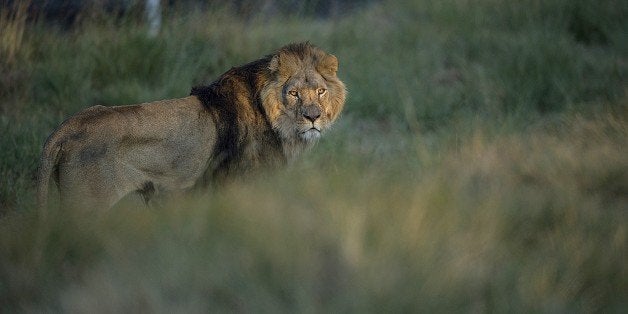
On March 1, 2011, Born Free USA, along with partner organizations including the Humane Society of the United States and International Fund for Animal Welfare, petitioned the U.S. Fish and Wildlife Service (USFWS) to list the African lion as Endangered under the U.S. Endangered Species Act (ESA). For more than four years, we waited... and waited. What should have been published as early as May 2013 has finally arrived this week: lions added to the ESA! Those in West and Central Africa listed as Endangered; those in East and South Africa listed as Threatened.
They say 'better late than never,' but the delay of the final USFWS decision has resulted in the deaths of at least 2,232 lions in the past four years -- including Cecil the lion, who was killed by an American trophy hunter in July.
Perhaps now, lions will be safe from the callous American trophy hunter; lion families can remain intact; and populations can rebound from near catastrophic losses.
The African lion is estimated to live on a fragmented 8 percent of its historic habitat across Africa. The species is estimated to have suffered serious population declines since 1980, when an estimated 75,800 lions roamed the African savannah. Now, experts believe there may be 20,000 or fewer. This is a species in true danger.
The African lion has not only lost its habitat, but as it loses habitat, it loses access to natural, wild prey and is forced to feed on livestock. This often results in retaliatory killing by livestock owners, who sometimes use nasty, horrific poisons that not only kill the lions, but anything else that has a taste for carrion. Diseases like Feline immunodeficiency virus (FIV) and Canine Distemper can also run rampant in regional lion populations, compromising the immune systems of hundreds of lions. The African lion is also killed in countries like Nigeria for their organs, fat, tissue, bones, blood, and other body parts to be used in traditional medicines. And, of course, hundreds of African lions are killed every year by trophy hunters -- more than half of whom, I'm ashamed to say, come from the U.S.
Had the USFWS listed the African lion as Endangered three, even two, years ago, perhaps Cecil wouldn't have suffered for more than 40 hours and died. Perhaps the African lion -- the king of the jungle -- would have been spared from the American wealthy hunting elite, who would have had to spend their money and satisfy their blood lust elsewhere.
More than 500 Cecils are inexplicably slaughtered every year... for fun. How senseless.
It's always easy to look back and dwell on what should have happened or what could have happened: to focus on the animals we have lost. However, with this year -- Cecil's year -- coming to an end, it's now time to look forward and celebrate the lions who will be protected from this point onward.
The announcement to list lions is a victory for animal protection and wildlife conservation; it's a victory for sound conservation science; it's a victory for the U.S. government, which has shown that the ESA is relevant and that America remains a conservation leader; and it's a victory for lions everywhere.
We certainly need more victories for animals!
Keep Wildlife in the Wild,
Adam
